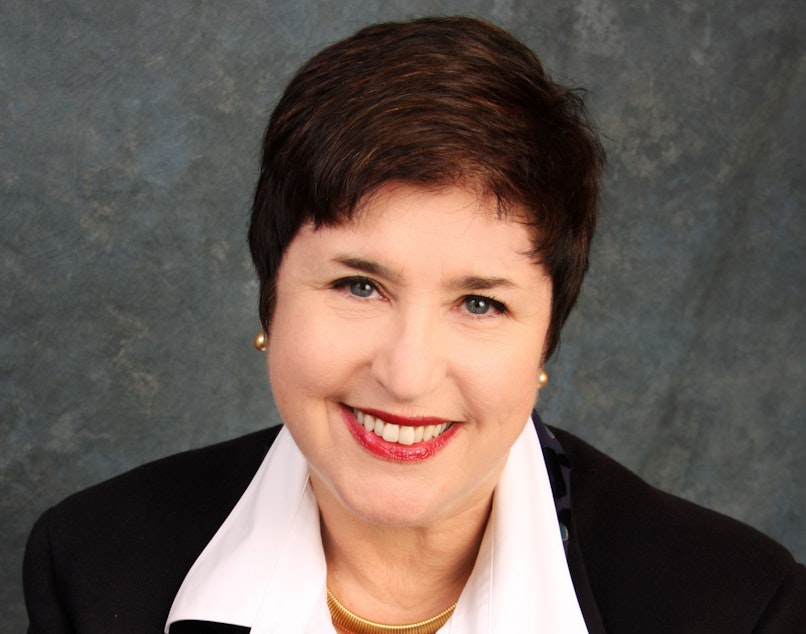Seattle Woman Experiences Financial Devastation Following Cancer Diagnosis

June 2 is National Cancer Survivor Day. But surviving the disease is just one challenge facing cancer patients. A recent study by Seattle’s Fred Hutchinson Cancer Research Center showed that cancer patients are two-and-a-half times more at risk for filing bankruptcy compared to people without cancer.
Celeste Smith of Seattle has experienced first hand the financial devastation of cancer. Five years ago, Smith was diagnosed with breast cancer. She was 58 years old at the time and just starting a new career as a realtor, her dream job. “This is my professional photograph for real estate,” she says, looking at a photo that was taken a month before the diagnosis. “This was on my card and on my brochure.”
At the time, Smith had a beautiful home in Redmond. She had a gardener and a cleaning person. She drove a BMW. Life was good. “When I look at that face sometimes, I had no idea what was going to be in store for me for the next five years,” she says. “You sit there so innocently, smiling. You don’t even realize your world is going to be so rocked.”
The cancer was more aggressive than originally thought. It would require intensive treatment that lasted nearly two years. At first Smith thought she could juggle work and chemotherapy. Soon she found out that wasn’t realistic. “I was exhausted. In one moment, it took all my energy and from then on I was just exhausted.”
She decided to put her work on hold until her health improved. Her insurance covered most of her treatment. But she had no income. She lived off her retirement and paid bills with credit cards, a move that would haunt her. Eventually she didn’t have any way to pay the bills or even buy food. “I had a big pantry, and being half Italian, [it was] full of food,” she says. "And I ate out of that pantry for a long time,” Smith says.
Then she was down to just Top Ramen and Cup-a-Soups. “I ate Cup-a-Soups for three days. And I just lost it,” she says. “And I went to DSHS and said I can’t do this anymore.”
The Department of Social and Health Services signed her up for food stamps and Medicaid for medical coverage. But that didn’t stop the bills from mounting. Collection agencies kept calling, and foreclosure notices were coming in. Smith says the sad thing was, she survived the disease, but the process financially ruined her. “I got so depressed because here my treatment’s been over since October, and it’s August and I’m in this mess, and I just started crying. And I cried for two months every day, thinking I would get over that since I’m so strong. And I couldn’t.”
Friends tried to help. They loaned her money. She tried to sell her house to pay them back. When it didn’t sell, a friend suggested that she file for bankruptcy. But she didn’t even have the money to file. So he paid the fee. “I don’t hate many things,” Smith says. “But I hate cancer and what it does to people, physically, emotionally and financially.”
Smith’s story is not uncommon. According to the recent Fred Hutchinson study, more than 4,000 cancer patients in Western Washington filed for bankruptcy in the last decade.
Dr. Scott Ramsey, the study’s lead author, says these findings highlight the least-discussed problem associated with the disease. “The larger societal question is whether it’s acceptable for cancer patients to suffer such extreme financial hardship in very large proportions,” he says. “And if we don’t, we have to think of larger ways to address that.”
Ramsey says having health insurance doesn’t shield patients from financial hardship, especially with increasing co-pays and deductibles.
For people recently diagnosed with cancer, it helps to map out contingencies, says Darol Tuttle. Tuttle is a lawyer who specializes in elder law and estate planning. He helps clients come up with plans for long term care, which is a lot like planning for cancer care. “It doesn’t matter what the diagnosis is, it doesn’t matter the age,” he says. “All of my clients have one problem, and that is a serious medical condition of some sort, high medical costs, possibly reduced income, and limited assets.”
Tuttle advises clients to come up with what he calls a living care plan. It’s a lot like planning a road trip. You look at your budget and plan for lodging, alternate routes, things like that. In addition, you plan for emergencies like a flat tire; the what-if’s. “What if the disease reaches the point where we could only work part time,” he says. “That is a scenario that has a different financial impact. What if along the way we had a major complication. That needs to be identified ahead of time.”
Tuttle says he likes to plan down to the penny, month by month for the next five years. It’s a lot of planning, but your future depends on it, says Tuttle. “This is the most important planning that you will ever do in your entire life.”
It’s been five years since Smith’s cancer diagnosis. Looking back, she says she wishes she’d had a larger team beyond the medical specialists. The team would also include social workers and those who could help navigate the financial minefield. “People survive cancer now,” she says, “we can’t just leave them wounded and emotionally spent, financially ruined and put them back there and go ‘you’re fine now.’”
These days, Smith lives in West Seattle in an affordable housing building for seniors. She survives on Social Security Disability. She still has personal loans she intends to pay back, but she’s not sure how. She hopes her journey will help those who are just starting theirs.

